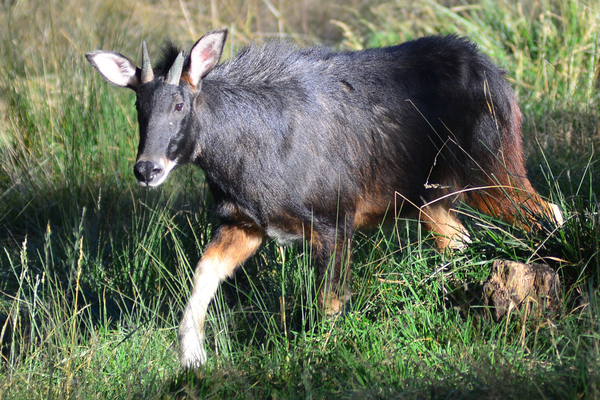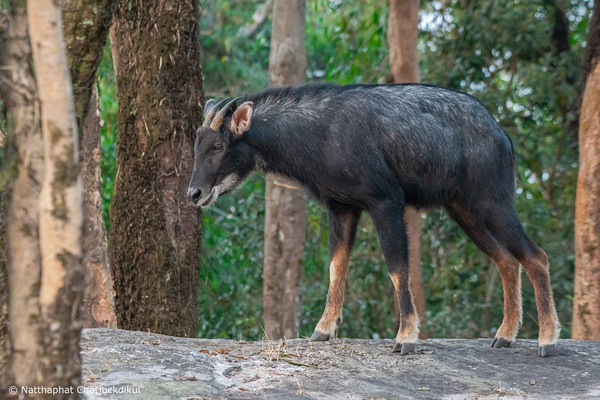The Chinese goral (scientific name: Capricornis milneedwardsii), also known as the mountain donkey or heavenly horse, is a unique and fascinating species found in East Asia. This article provides an in-depth look at the species, covering its classification, physical traits, behavior, habitat, and conservation efforts.
The Chinese goral belongs to the family Bovidae and is part of the Caprinae subfamily, which includes other goats and sheep. It is closely related to other members of the genus Capricornis, such as the Sichuan goral and the Himalayan goral. Its scientific name is Capricornis milneedwardsii, and it was first described in 1900 by the British zoologist Oldfield Thomas.
Kingdom: Animalia
Phylum: Chordata
Class: Mammalia
Order: Artiodactyla
Family: Bovidae
Genus: Capricornis
Species: C. milneedwardsii
The Chinese goral was first identified and classified in the late 19th century. Since its discovery, this species has intrigued zoologists and conservationists due to its elusive nature and its unique adaptations to high-altitude environments. It is mainly found in the mountain ranges of Central and Eastern China and parts of northern Vietnam.

The Chinese goral is a medium-sized herbivore with distinct physical traits that make it well adapted to rugged terrains.
Appearance: The goral has a sturdy, compact body that helps it navigate rocky and steep landscapes. Its coat is typically short and thick, offering protection from the cold, especially in mountainous regions.
Size: Adult males can weigh between 30 to 45 kilograms (66 to 99 pounds), while females are generally smaller, weighing around 20 to 30 kilograms (44 to 66 pounds).
Lifespan: The average lifespan of a Chinese goral in the wild is estimated to be between 10 and 15 years.
Physical Features: The goral has a distinctive pair of horns that are short, backward-curved, and present in both males and females. These horns are used in territorial disputes and as a defense mechanism against predators.
The Chinese goral primarily inhabits the mountainous regions of Central China, including parts of Sichuan, Gansu, and Yunnan provinces. It is also found in the northern Vietnam regions, particularly in areas that are densely forested and rugged.
Elevation: The Chinese goral lives in habitats at elevations ranging from 1,500 to 3,000 meters (4,900 to 9,800 feet), where dense shrubs, forests, and steep cliffs provide ample hiding spots from predators.
Climate: The species prefers cooler, temperate climates and is often found in areas that experience significant seasonal temperature fluctuations.
The Chinese goral is a crepuscular animal, meaning it is most active during dawn and dusk. This helps it avoid predators and human activity during the daytime.
The Chinese goral is generally solitary, with males and females coming together only during the mating season.
Young goral usually stay with their mothers until they are old enough to fend for themselves.
The Chinese goral is known for its agility on rocky cliffs and steep slopes. It can scale sheer rock faces with ease, thanks to its specialized hooves and powerful limbs.

Unlike migratory species, the Chinese goral does not undertake long migrations. However, during the winter months, it may descend to lower altitudes to find food and shelter. This seasonal movement is generally driven by temperature changes and the availability of food.
The Chinese goral is primarily herbivorous, feeding on a wide range of shrubs, grasses, and leaves. It forages throughout the day, focusing on areas with abundant plant life.
The species exhibits territorial behavior, especially during mating seasons when males establish and defend their territories.
Though solitary by nature, the Chinese goral will interact with others of its species during mating or in areas where food resources are abundant.
As herbivores, Chinese gorals have a diverse diet, mainly consisting of:
Grasses: They graze on fresh, nutrient-rich grasses.
Shrubs and Foliage: They also feed on young shoots, twigs, and leaves from trees and shrubs.
Due to its adaptations to mountainous environments, the Chinese goral has a high tolerance for tough, low-nutrient plants and can survive in areas with limited food resources.
Mating Season: The mating season for Chinese gorals occurs in late autumn to early winter.
Gestation Period: Females carry their young for 180 to 200 days, with births typically occurring in the spring.
Offspring: Typically, a single kid (young goral) is born, although twins are possible.
Mother and offspring will stay together for several months until the young goral is capable of independent survival.
The Chinese Serow is becoming endangered due to habitat destruction and frequent overhunting. It is listed as the second level of China's "National Key Protected Wildlife List". It is listed as a vulnerable (VU) species in the "Red List of Endangered Species of the World Conservation Union" (IUCN). It is listed in the Appendix of the "Convention on International Trade in Endangered Species of Wild Fauna and Flora" (CITES).
The Chinese goral is classified as Near Threatened (NT) by the International Union for Conservation of Nature (IUCN), and it faces a number of challenges:
Habitat Loss: Deforestation and human encroachment have drastically reduced its natural habitat.
Poaching: Illegal hunting for meat and fur has further diminished its population.
The Chinese government has implemented various measures to protect the species, including creating protected areas in key habitats.
Anti-poaching laws are enforced in areas where Chinese goral populations are known to reside.
The Chinese goral plays a critical role in maintaining the balance of its ecosystem. By consuming shrubs and grasses, it helps control plant growth, preventing overgrowth and allowing other species to thrive. It also serves as a prey species for larger carnivores, contributing to the food chain's stability.
In Chinese culture, the goral is often associated with strength and resilience, symbolic of its ability to thrive in harsh mountain environments. Although not as widely celebrated as other animals, it has become a symbol of wildlife conservation in the regions it inhabits.
While the Chinese goral has limited direct economic value, its existence is crucial to the health of local ecosystems, which in turn supports tourism and ecotourism. The presence of rare and unique species like the goral can attract eco-tourists to protected areas, boosting local economies.

| Species Name | Common Name | Habitat Location | Conservation Status |
|---|---|---|---|
| Capricornis milneedwardsii | Chinese Goral | Central China, Vietnam | Near Threatened (NT) |
| Capricornis sumatraensis | Sumatran Goral | Sumatra, Indonesia | Vulnerable (VU) |
| Capricornis swinhoei | Taiwan Goral | Taiwan | Endangered (EN) |
This article provides a detailed overview of the Chinese goral (Capricornis milneedwardsii), covering its classification, physical traits, behavior, conservation status, and more. By increasing awareness and supporting conservation efforts, we can ensure the survival of this unique species in its natural habitat.
animal tags: Bovidae
We created this article in conjunction with AI technology, then made sure it was fact-checked and edited by a Animals Top editor.